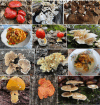Variation in traditional knowledge of culturally important macromycete species among three indigenous communities of Oaxaca, Mexico
- PMID: 38519986
- PMCID: PMC10958891
- DOI: 10.1186/s13002-024-00679-8
Variation in traditional knowledge of culturally important macromycete species among three indigenous communities of Oaxaca, Mexico
Abstract
Background: For centuries, wild mushrooms have been a forest resource of significant cultural value in several ethnic groups worldwide. In Mexico, extensive traditional knowledge on the use of fungal resources has been developed and deeply rooted. Mexico is the second country in the world in which the most species of wild mushroom are consumed, and it is considered a pioneer in ethnomycology. Nonetheless, there are still many indigenous groups in this country that have not been studied from an ethnomycological approach. The present study aimed to record the traditional knowledge on wild mushrooms in three indigenous groups of the state of Oaxaca, Mexico, and assess the variation in this knowledge within and across the studied groups.
Methods: The data were recorded from April to October 2022 within three communities belonging to the indigenous groups Chatino, Chontal, and Chinanteco. Through 84 interviews, information related to their knowledge of wild mushrooms was obtained. The cultural significance index of wild edible mushrooms was calculated for each community. Regression analyses, analysis of variance and covariance, t test, and non-metric multidimensional scaling analysis were performed to assess the distribution of traditional knowledge in the communities.
Results: A total of 32 culturally important mushroom species were recorded for the three indigenous groups (30 edible, 2 medicinal); 23 used by Chatinos, 16 by Chontales, and 6 by Chinantecos. Only Chatinos and Chinantecos use wild mushrooms in medicine. The cultural significance of wild edible mushrooms differed among groups. Traditional knowledge about wild mushrooms declines when the level of schooling increases and age decreases, especially in the Chatino group. This knowledge distributes more homogeneously in the Chontal and Chinanteco groups. Their age determines the difference in knowledge between men and women.
Conclusion: Documenting how traditional knowledge differs among ethnic groups is relevant for preserving cultural and biological diversity. Factors such as level of schooling and age can affect traditional knowledge of wild mushrooms, but the effects of these factors vary within and across communities. Conducting studies encompassing a broader range of variables is of interest for a better understanding of the human-mushroom relationship.
Keywords: Chatinos; Chinantecos; Chontales; Edible mushrooms; Ethnomycology; Indigenous nomenclature; Medicinal mushrooms; Traditional knowledge; Wild mushrooms.
© 2024. The Author(s).
Conflict of interest statement
The authors declare that they have no competing interests.
Figures







Similar articles
-
Folk taxonomy of wild mushrooms in communities of the indigenous groups Chatino, Chontal, and Chinantec in Oaxaca, Mexico.J Ethnobiol Ethnomed. 2025 May 1;21(1):30. doi: 10.1186/s13002-025-00779-z. J Ethnobiol Ethnomed. 2025. PMID: 40312355 Free PMC article.
-
Traditional knowledge and use of wild mushrooms by Mixtecs or Ñuu savi, the people of the rain, from Southeastern Mexico.J Ethnobiol Ethnomed. 2016 Sep 5;12(1):35. doi: 10.1186/s13002-016-0108-9. J Ethnobiol Ethnomed. 2016. PMID: 27595599 Free PMC article.
-
Cultural, economic, and ecological factors influencing management of wild plants and mushrooms interchanged in Purépecha markets of Mexico.J Ethnobiol Ethnomed. 2018 Nov 20;14(1):68. doi: 10.1186/s13002-018-0269-9. J Ethnobiol Ethnomed. 2018. PMID: 30454000 Free PMC article.
-
Sociocultural drivers of mycological knowledge: insights from Wixarika and Mestizo groups in western Mexico.J Ethnobiol Ethnomed. 2022 Nov 18;18(1):68. doi: 10.1186/s13002-022-00564-2. J Ethnobiol Ethnomed. 2022. PMID: 36401266 Free PMC article. Review.
-
Wild Edible and Medicinal Mushrooms Used by the Tribes in the State of Kerala, India: A Review.Int J Med Mushrooms. 2022;24(9):63-72. doi: 10.1615/IntJMedMushrooms.2022044605. Int J Med Mushrooms. 2022. PMID: 36004710 Review.
Cited by
-
Current use of holy mushrooms of the genus Psilocybe in a Zapotec community in Oaxaca, Mexico.IMA Fungus. 2025 May 23;16:e148070. doi: 10.3897/imafungus.16.148070. eCollection 2025. IMA Fungus. 2025. PMID: 40453385 Free PMC article.
-
Folk taxonomy of wild mushrooms in communities of the indigenous groups Chatino, Chontal, and Chinantec in Oaxaca, Mexico.J Ethnobiol Ethnomed. 2025 May 1;21(1):30. doi: 10.1186/s13002-025-00779-z. J Ethnobiol Ethnomed. 2025. PMID: 40312355 Free PMC article.
References
-
- Mueller G, Foster M, Bill G. Biodiversity of fungi. Inventory and monitoring methods. Academic Press, Amsterdam; 2004.
-
- Gryzenhout M, Roets F, de Villiers R. Fungal conservation in Africa. Mycol Balc. 2010;7:43–48.
-
- Boa E (2005) Wild edible fungi. A global overview of their use and importance to people. In: Non-wood forest products 17. Food and Agriculture Organization of the United Nations, Italy
-
- Lodge DJ. Nutrient cycling by fungi in wet tropical forests. In: Isaac S, Frankland JC, Watling R, Whalley AJS, editors. Aspects of tropical mycology. Cambridge: Cambridge University Press; 1993. pp. 37–57.
-
- Voces R, Diaz-Balteiro L, Alfranca Ó. Demand for wild edible mushrooms: the case of Lactarius deliciosus in Barcelona (Spain) J For Econ. 2012;18(1):47–60.
MeSH terms
Grants and funding
LinkOut - more resources
Full Text Sources
Miscellaneous

